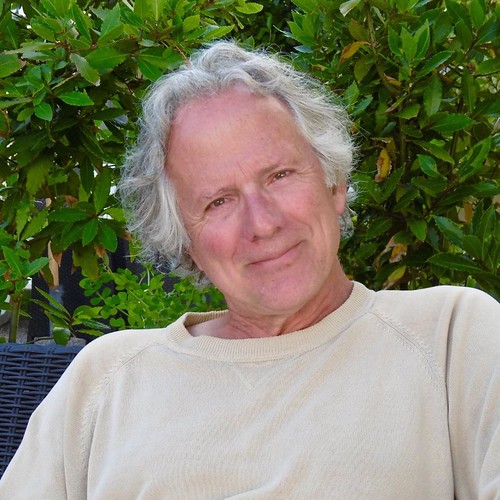FEATURES|COLUMNS|Creativity and Contemplation
Harmonic Presence: Qualities of Silence, Listening, and Sound with David Hykes
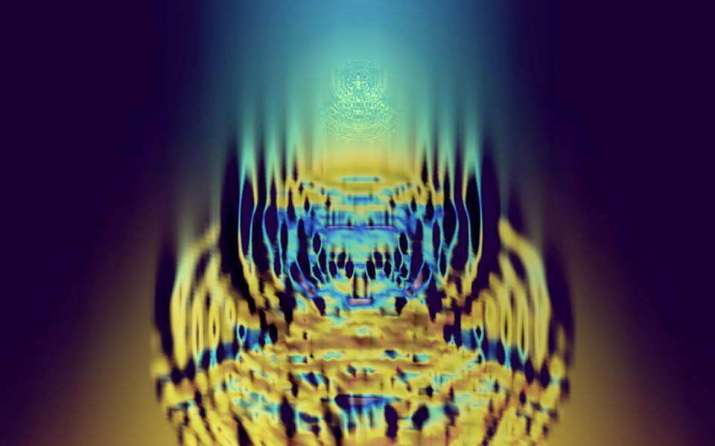 Harmonic Vision: Portrait of Lucy, My Taos Pueblo Godmother, 2008 © David Hykes
Harmonic Vision: Portrait of Lucy, My Taos Pueblo Godmother, 2008 © David HykesLeonardo da Vinci is known to have been one of the very first to recognize that the same laws apply to the human body and to cosmic phenomena. . . . The microcosm and the macrocosm are indeed intimately related! — Astrophysicist Mario Livio*
Composer, singer, and contemplative mentor David Hykes is the founder of the Harmonic Presence work, which unites “music of the spheres of being” and Harmonic Chant with contemplative practice and exercises for healing. When I caught up with him, David had just returned to Pommereau, his 12th century Cistercian home and retreat center near the Loire River southwest of Paris, from a Tibetan Buddhist center near Montpellier, where he and several hundred other students had been snowed in during a teaching with Dzongsar Khyentse Rinpoche, creating a magical occasion. Rinpoche gave refuge and bodhisattva vows, reminding those present that prayers for peace and wellbeing are for all beings—no exceptions. This took place during Chötrul Düchen, the Festival of Miracles, when prayers and wishes are amplified 10,000,000 times. I can imagine the almost imperceptible sound of blanketing snowfall amid the grand winter silence of the occasion.
Vibrational ecology and eco-Buddhism
David leads Harmonic Presence retreats that are inspired by his Buddhist studies. There he and his students address what it means to be fully human by tuning in to the nature of all inner and outer phenomena. This becomes compassionate accompaniment and a self-liberating experience. The well-being and healing harmonization dimensions of the retreat play an important role in truly hearing the nature of our suffering and unhappiness.
David’s work connects subtle listening and sounding, and the sphere of silent attunement—not only to harmonics, but to a fuller spectrum and scale of being human: what is the innermost nature of harmony, at every scale of being, of the universe? The juxtaposition of microcosm and macrocosm figures strongly in David’s work through the co-presence of “as above, so below,” and his focus on what he calls the “chords of being,” subtle qualities of mind, sound, breath, listening, silence, space, and resonance.
David also works with the relationships between sound vibration and visual form. As a filmmaker in the 1970s, he became inspired by cymatics, the sound visualization work of Hans Jenny, and visited Jenny’s family in Switzerland. Through Harmonic Visions, David uses Harmonic Chant and mantras to transform sound into real-time flowing visual forms. For these “vibrational portraits,” he uses the sung and chanted name of a person to create their sonic portrait, to encourage healing, to inspire, to commemorate, to remember them.

Harmonic Presence Retreat at the Esalen Institute in 2010, with David Hykes,
back row, third from left © Daniel Bianchetta
Our conversation initially centered on the state of our physical world and global climate change. David relates this disequilibrium to our lack of awareness of our inner “climate changes,” as well as our lack of listening awareness, and addiction to noise inside and out, on both literal and symbolic levels. Sounds, silence, and listening are all active ingredients of communication, and David emphasizes that as human beings we are often unaware of our own core of silent listening, and of the effects on our society of our noisiness and our own often-overheated inner atmosphere. He connects our outer atmospheric climate problems to inner climatic imbalances in our “wind energy;” lung in Tibetan, prana in Sanskrit.
I thought of pianist Ludovico Einaudi’s poignant, heartbreaking performance in the Arctic, his Steinway balanced on a makeshift raft.** It reminds me why it is the artist-meditators of our time who inspire me to reach out through the written word. It is artists who model, who dare to show in every possible expressive way, not only our most pressing issues, but also a path toward light, healing, and sanity. What Chögyam Trungpa Rinpoche called basic goodness, cultivated through meditation, civic action, and creative means. With bodhisattva motivation, one finds the music within silent listening, touching the true nature of silence. Listening is one chord of the symphony of being, in tune with all other beings. By taking the question, where does listening stop and sound begin? as a koan, one can awaken to co-emergent present awareness.
We spoke of what David calls “vibrational ecology” and its relationship to eco-Buddhism—relating to our inner atmosphere and climate and its changes as part of, and a major cause of, what the world is going through right now. Ecological concerns have become more and more important in the Dharma world, thank goodness, increasingly supported by meditation teachers from many lineages.
Like wounded warriors, we must care deeply for our planet, each other, and ourselves—and be models for our youth, who are poised to be our future leaders. What kind of a world are we leaving for them? As Buddhists, we pray and offer pujas, as well as take action for children’s health, safety, and education. (Among many remarkable examples of educational endeavors combining spiritual and whole-Earth awareness are Tsoknyi Rinpoche’s Tsoknyi Gechak School in Nepal and the Middle Way School in Saugerties, New York.***)
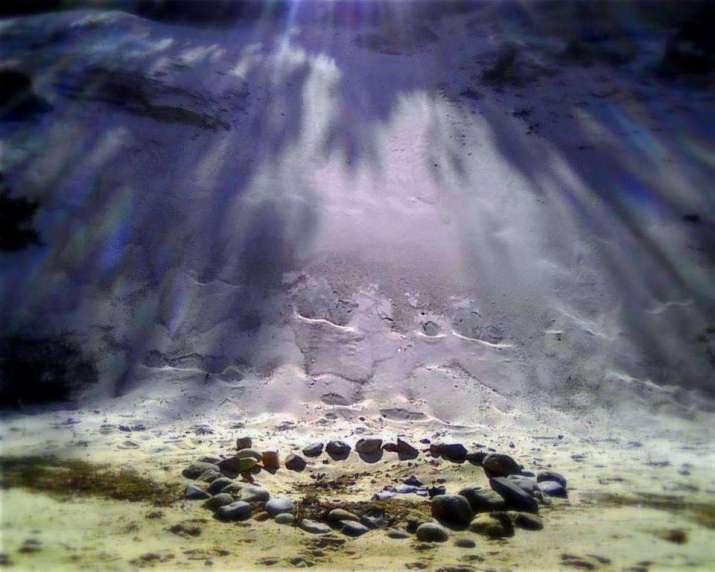 Vajrayogini Holy Fire, 2016 © David Hykes
Vajrayogini Holy Fire, 2016 © David HykesHarmonic Chant
David founded Harmonic Chant in New York in 1975 with his original group, the Harmonic Choir. He was inspired by sacred music and chant of both East and West, and by a growing awareness in the Western avant-garde music world of the primordial nature of musical sound. The harmonic series, as universal in sound as the color spectrum is to light, is the DNA of all music and the common source for melody, harmony, and rhythm. Harmonic Chant is a range of full-spectrum and fully embodied practices exploring both the inner and outer. Listening follows sound, but for a full experience we also need, as good gardeners of being, to cultivate listening inwardly to the depths of sound and awareness origination.
David was the artist in residence at the Cathedral of St. John the Divine in New York City with his group for 10 years, before he moved to France with his family. In the summer, many French cathedrals are the site of son et lumière experiences, sound and light installations inside and out, visually echoing the oft-forgotten fact that the stone walls of abbeys and churches were originally often polychromatic! In contemplative Christianity, the universal essence of resonance expresses a connection with the global village through a broad field of sound and visuals. In 1987, France’s Ministry of Culture invited David to create performances in these ancient stone cathedrals. Originally in France for a one-year residency, he decided to stay on and establish a home base for his sonic and spiritual pilgrimages. He refers to Europe’s magnificent cathedrals as “the great indoors.”
Rather than always being the “soloist” in our lives, we can instead cultivate a spirit of pure accompaniment to whatever arises, whatever is happening, spontaneously available and present. This is another aspect of bodhisattva motivation. Working with sound, listening, and breath is a perfect way to be in the moment, free of noisy distractions inside and out; to simply recognize and respond. David likens this to the way a child silently marvels as a bird flies by; wonder and magic are fully present, fleeting yet rich. He works alongside participants in contemplative seminars and retreats, exploring sonic resonances of awareness in real time.
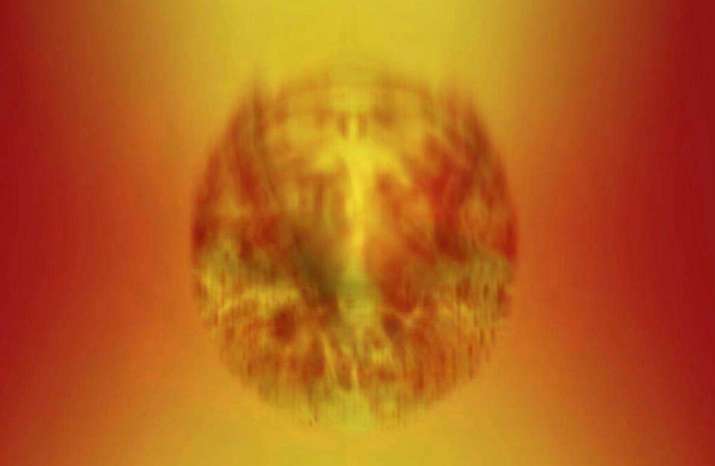 Harmonic Visions: Healing Vision #1, for Uma, 2011 © David Hykes
Harmonic Visions: Healing Vision #1, for Uma, 2011 © David HykesCreating sound mandalas is a key theme in the Harmonic Presence work, based on what David calls “soundbeam construction,” reminiscent of the collective nature of sacred form in so many traditional cultures, whether of ceremonial spaces, cathedrals, or temples. The collaborative focus is in the accompaniment of the arising, remaining, and dissolving nature of all phenomena. This is the way to receive “the whole picture” and better help and harmonize phenomena—not only in our inner worlds, but in the world at large.
Distortions of nature and society in the outer world mirror our lack of inner harmony. Our innate chords of being can easily become discords of being—imbalances, whether in body, speech, mind, or spirit. By harmonizing within we create complementary power to tone down the outer phenomena for which we are responsible. If we neglect to do so, we remain in what David refers to as our ever-confused state of “me, myself, and minefield.”
Roots
Born in Taos, New Mexico, David was strongly influenced by Native Pueblo culture and music. His passion for sound and harmonics first came from working as a filmmaker in experimental, underground films. Calling himself a “wholehearted devotee of sound and light,” he wanted to explore their spectral relationship or dance. In pairing sound and light, he discovered a primordial coupling as described in traditional Buddhist texts on non-duality. This intrigued David, and he wanted to create what he called “prismatic sound” for his films. He began by utilizing a woman’s voice, discovering for the first time that using a harmonizer (a kind of sampling device), he could refract her voice and create a full range of harmonics with tones, overtones, and undertones. He did this before ever hearing Tibetan and Mongolian overtone singing!
David’s work with harmonics is a union of the Western awareness of the harmonic nature of sound and non-tempered tunings from the harmonic series, and his own immersions with the “sonic backbone” of Eastern (Tibetan and Mongolian) chanting. His work has had a clearly contemplative dimension from the beginning—based on the trinity of a harmonic sound stream, the practice of listening, and silent ground (or all-ground, Skt: alaya) from which it arises. Completely enthralled by the very few recordings of Tibetan and Mongolian chant he managed to find in 1973, even in New York City, he built a soundproof room in his loft apartment, where he immersed himself for several weeks, emerging with both his listening and vocal approaches transformed.
 The Goddess Who Flew Over the Lake, 2010 © David Hykes
The Goddess Who Flew Over the Lake, 2010 © David HykesDavid was invited to Mongolia in 1981 and over the years has received much support and encouragement, especially from the Tibetan Buddhist world, the Gurdjieff Work, from his original Taos Pueblo spiritual family, and from his Indian raga guru, Smt. Sheila Dhar, all of whom offered guidance and mentorship on his sound journey.
The true nature of listening
Harmonic Presence work involves as much the cultivation of qualities within the silent state as it does in cultivating sound. This means becoming sensitive to the complete spectrum of awareness and its relation to all phenomena. Science likes to say that “the observer changes the observed.” David finds this quite dualistic, as it is equally true to realize that the observed changes the observer. The listener also changes what is listened to and the listened to changes the listener—opening a non-dual, two-way channel. If one learns to listen, this is active accompaniment, as listening and silence are integral aspects of sound. Listening to others becomes more important—the way we listen is like a note in a chord of what is being said. There is a subtle fluidity in the exchange, just as in breathing in and out.
If, as meditators, we take phenomena as the mirror of our own awareness, then what is reflected back to us, with and from perception, becomes interactive, a living conversation. Changes in our world, including climate change, include our awareness of it—thanks to the non-dual field of the silent ground. Arising in that space, our thoughts and sounding make as much difference as our actions in the big picture. A note is a portal to go through—into all directions. Being aware of the harmonic nature of sounds, whether in community or nature, reminds us that being itself is polyphonic. To discover this is akin to finding water after a long drought—it seems like a new discovery, though it is actually our birthright or heritage.
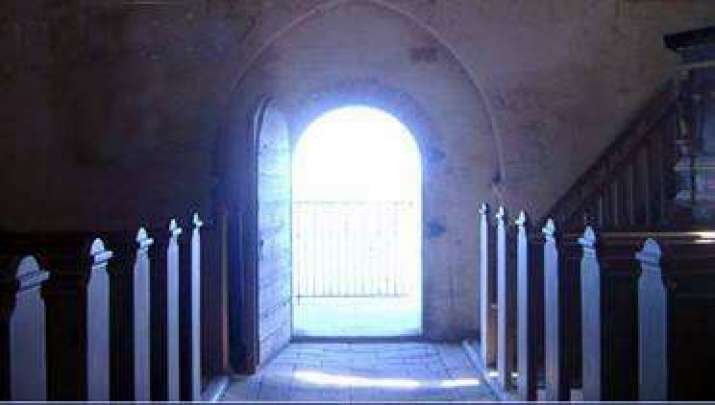 Retreat church above the sea, Denmark 2007 © David Hykes
Retreat church above the sea, Denmark 2007 © David HykesSacred images from sound waves
David used to create the Harmonic Visions in his concerts with substances such as mercury, sand, or water, set into vibration from the chanting. Following his inspirations in the mid-1970s from this work with vibration made visible, performance artists such as Björk have since used this technique. Over the last 20 years or so, David has been developing Harmonic Vision software, based on wave visualization. This real-time transformation of the voice spectrum, as with mercury, models how sound waves vibrate in a pool. When transforming mantra into light forms, David is inspired by sublime sacred events such as the treasure teaching (Tib: terma) discovered by the great master Dilgo Khyentse Rinpoche. Legend states that while looking at a lake in Tibet, letters rose up and vibrated on the surface of the water: “. . . of these terma visions, Khyentse Rinpoche saw the complete mandala of the Buddha of Eternal Life (Amitayus) appear on the surface of a lake in eastern Tibet.” ****The connections between vibration and form—flowing geometric patterns of circles, ovals, figure eights, flowing triangle shapes, and more—create a portal to the inner geometry aspects of sound and light as one, a secret bridge between music, form, and awareness! This work is deeply exciting and rewarding for David to share with others.
Healing visions: the Vibrational Portraits series
When a longtime friend fell ill, David found himself chanting his friend’s name and creating harmonic visions from the sound. The result was an inspiring vibrational manifestation related to the sound of her name, a unique form of sending wishes and prayers in both sound and light, as an offering.
The portal of Harmonic Chant has changed David’s life, as has the discovery of harmonic visions. David loves to chant the Vajra Guru mantra (Om Ah Hung Vajra Guru Pema Siddhi Hung) to create visual and vibrational forms closely connected to his meditational practice. Like the art of glass blowing, he uses breath to create form in brilliant color. Breathing life into form provides a rich exploration of the elemental and unseen worlds. Chanting can reharmonize one’s prana and life force, one of the bases for his retreats and teaching. Through exploring sound and silence, breath and sound, breath and form, in the whole sphere of human experience, the inner and outer worlds come into greater intimacy, and healing harmonization for oneself and others and for nature can be enriched.
* The Microcosm and the Macrocosm(Huffington Post)
** Greenpeace holds a historic performance with pianist Ludovico Einaudi on the Arctic Ocean(YouTube)
*** Tsoknyi Lineage Nuns; Middle Way School
**** Ricard, Matthieu. 1996. Journey to Enlightenment: The Life of Dilgo Khyentse Rinpoche. Boulder: Shambhala Publications.
A Vajrayana Buddhist practitioner since 2000, Sarah C. Beasley (Sera Kunzang Lhamo) spent close to seven years in retreat under the guidance of Lama Tharchin Rinpoche and Thinley Norbu Rinpoche. She is an experienced teacher, writer, sculptor, photographer, dancer, and Iyengar yoga practitioner. Sarah offers a workshop, “Meditations for Death, Dying & Living,” based on the text Vajrasattva Ceremony for the Dead (Concise Nay Dren). For more information, visit Moondrop.
See more
Related features from Buddhistdoor Global
When Guanyin Jumps Off a Cliff
The Sound of Awakening: Meeting the Mongolian Yogini Kunze Chimed
The Silent One: Leonard Cohen’s Pursuit of Spirituality

